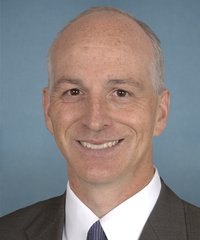
Adam Smith was born on June 15, 1965, in Washington, D.C. Adam was raised in SeaTac, Washington where his father, Ben, worked as a ramp serviceman at SeaTac Airport and was active in the local Machinists’ Union. His mother, Leila, stayed at home, raising Adam and his two brothers. Adam attended Bow Lake Elementary, Chinook Middle School, and Tyee High School, graduating from Tyee in 1983.
After a year at Western Washington University, Adam transferred to Fordham University, where he worked his way through college loading trucks for United Parcel Service and graduated in 1987 with a degree in Political Science. Following his graduation, Adam attended the University Of Washington School Of Law, and earned his law degree in 1990. He later worked in both private and public practice, first as a lawyer at Cromwell, Mendoza and Belur in 1992, and then as a prosecutor for the City of Seattle from 1993-1995. As a prosecutor, Adam focused on drunk driving and domestic violence cases, and in 1996, went on to work as a judge pro tempore.
Communities surrounding Sea-Tac Airport and other airports in the region have come to experience an increased and disproportionate share of noise and other environmental impacts stemming from increases in air traffic. Studies have demonstrated that communities near airports and airflight pathways are exposed to higher proportions of pollution and harmful particles from aviation emissions. This can lead to increased risks of breast cancer, heart disease, asthma, and a variety of other lung and cardiovascular conditions. Aviation noise and emissions also disproportionately affect low-income communities and communities of color.
I have worked with residents of the Ninth Congressional District and community organizations such as Quiet Skies Puget Sound and the Beacon Hill Noise Team to bring their concerns to the Federal Aviation Administration (FAA) and the SeaTac airport. It is a priority of mine to ensure that not only are residents’ concerns heard, but that solutions are put forward to reduce noise and environmental impacts for all. This includes:
I have also introduced several pieces of legislation on the topic of aviation noise and emissions, including:
Aviation Noise and Emissions Mitigation Act: Creates two new pilot grant programs at the EPA for studies of air quality and noise and for mitigation projects in communities, focused on communities of color and low-income communities. The bill will help us to better understand the effects of noise and emissions and fund initiatives driven by communities to mitigate these effects on the environment, public health, and quality of life of residents living near airports and airflight pathways.
Protecting Airport Communities from Particle Emissions Act: This bill would require the FAA and EPA to jointly partner with an institution of higher education to study airborne ultrafine particles (UFPs) and their effect on human health.
Noise Mitigation Repair and Replacement Act: This bill would establish a process by which airports may apply for additional Airport Improvement Program (AIP) funding to repair or replace noise mitigation packages. Current AIP regulations make it impossible for airports to get federal AIP funding for repairing and replacing sound insulation on homes originally insulated through the AIP noise mitigation program, even if those homes had products that have failed or that were installed in a manner that causes structural damage on a home.
Aviation Impacted Communities Act: The Aviation Impacted Communities Act seeks to help cities, localities, and neighborhoods to better and more productively engage with the Federal Aviation Administration (FAA). The legislation is geared particularly towards communities that have not been recognized as “impacted” by the FAA’s noise standard. This legislation would require that the FAA interface directly with and be responsive to residents and locally nominated leaders on issues of aviation noise and environmental impacts. Through the creation of local community boards, affected areas will be empowered to effectively work toward achieving relief from the impacts of civil and commercial aviation.